Why brine? Your guide to better, more tender meat
Published 4:30 pm Thursday, March 17, 2022

- Dry brine
A well-seasoned dish requires little more than salt. Spices, herbs and sauces are essential for boosts of flavor, but at a basic level, salt has the power to transform a dish from bland to flavorful.
Knowing when to salt your dish is a critical step in becoming a good cook, and brining is a salt-centric preparation process that brings so much flavor and texture to meat with very little effort. So, why brine?
Small effort, big flavor
Trending
Call it a good return on investment: A brine can come together in less than 10 minutes and allows a cook to tenderize and flavor-boost meat with almost zero hands-on effort. Once the brine is made and the meat is added, all that is left to do is to place the meat in the refrigerator and let it rest for up to 24 hours.
A simple cure
Brining — a process of preserving, flavoring or tenderizing with salt — is a time-honored technique that has been used for centuries to preserve food. Sweet and dill pickles, for example, are kept in a salty brine until ready to eat and remain edible for months to come. Meat packed in salt draws out moisture, curing the meat to keep it from rotting.
Wet versus dry
When it comes to brining, you have two options: a wet brine or a dry brine.
A wet brine is a saline solution. The salt in the brine works to break down the walls of fibrous cells, like muscle cells. Those weakened cells can then absorb as much moisture as they can hold, and because so much moisture is absorbed into the cell, there is less of a net loss of moisture during the cooking process. Salt also breaks down and softens connective tissues, making for a tender, juicy final result. That end result is the reason brining is a popular choice for preparing Thanksgiving turkey. Overcooked and dried-out meat is a definite fear for a Thanksgiving day cook (and eater) and brining helps prevent a subpar bird.
Dry-brining has a similar effect to that of wet-brining, although the overall goal of a dry brine is different. A wet brine, in which salt is dissolved in liquid (usually water), is a process of osmosis, allowing that salty liquid to permeate and pass through cells, bringing flavor along with it. Dry-brining focuses more on the meat’s surface. A generous layer of salt pulls moisture up through the skin or exposed muscle of meat, which means less moisture evaporation while cooking. A dry-brined chicken has crackling, golden skin, and dry-brined steak develops a flavorful crust with a deeply tender interior.
How much do you actually know about the salt in your cupboard?
Use this type of salt
Kosher salt is the go-to for creating a brine, as this salt was developed specifically for koshering meat (which is the process by which the blood is removed from the flesh of meat before it is prepared for eating), which follows many of the same principles as brining. Kosher salt has a flat surface that sticks well and distributes evenly over meat (good characteristics for dry-brining) and dissolves quickly in water. This type of salt’s unique flaky shape makes it less dense than table salt, which is finer and has less air between crystals of salt when measured. Important to note is that kosher and table salt have different weights by volume and are not interchangeable. Unless a recipe notes otherwise, use kosher salt in your brining efforts.
Most wet-brine recipes are more than just salt and water; they include a sweetener, spices and aromatics for added flavor. Once you develop a good brining ratio, you can add other ingredients to experiment with and expand flavors. Keep this in mind: For each cup of liquid, add one-quarter cup of kosher salt. Other liquids can be used in place of the water, but at least half of the total brining liquid should be water.
Check out these simple recipes for a wet and a dry brine:

